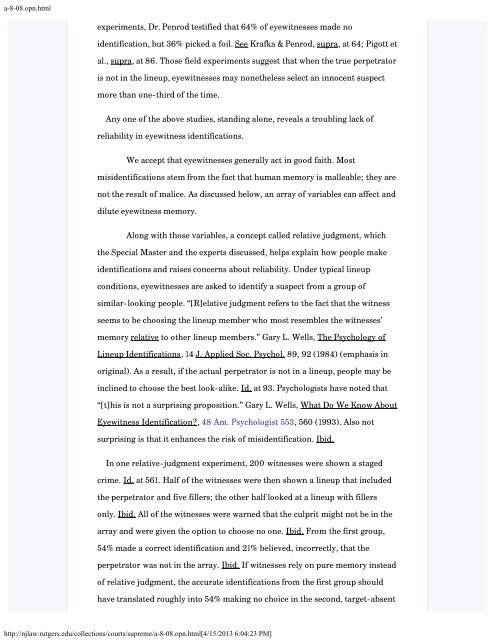State v. Henderson and the New Model Jury Charges - New Jersey ...
State v. Henderson and the New Model Jury Charges - New Jersey ...
State v. Henderson and the New Model Jury Charges - New Jersey ...
You also want an ePaper? Increase the reach of your titles
YUMPU automatically turns print PDFs into web optimized ePapers that Google loves.
a-8-08.opn.html<br />
experiments, Dr. Penrod testified that 64% of eyewitnesses made no<br />
identification, but 36% picked a foil. See Krafka & Penrod, supra, at 64; Pigott et<br />
al., supra, at 86. Those field experiments suggest that when <strong>the</strong> true perpetrator<br />
is not in <strong>the</strong> lineup, eyewitnesses may none<strong>the</strong>less select an innocent suspect<br />
more than one-third of <strong>the</strong> time.<br />
Any one of <strong>the</strong> above studies, st<strong>and</strong>ing alone, reveals a troubling lack of<br />
reliability in eyewitness identifications.<br />
We accept that eyewitnesses generally act in good faith. Most<br />
misidentifications stem from <strong>the</strong> fact that human memory is malleable; <strong>the</strong>y are<br />
not <strong>the</strong> result of malice. As discussed below, an array of variables can affect <strong>and</strong><br />
dilute eyewitness memory.<br />
Along with those variables, a concept called relative judgment, which<br />
<strong>the</strong> Special Master <strong>and</strong> <strong>the</strong> experts discussed, helps explain how people make<br />
identifications <strong>and</strong> raises concerns about reliability. Under typical lineup<br />
conditions, eyewitnesses are asked to identify a suspect from a group of<br />
similar-looking people. “[R]elative judgment refers to <strong>the</strong> fact that <strong>the</strong> witness<br />
seems to be choosing <strong>the</strong> lineup member who most resembles <strong>the</strong> witnesses’<br />
memory relative to o<strong>the</strong>r lineup members.” Gary L. Wells, The Psychology of<br />
Lineup Identifications, 14 J. Applied Soc. Psychol. 89, 92 (1984) (emphasis in<br />
original). As a result, if <strong>the</strong> actual perpetrator is not in a lineup, people may be<br />
inclined to choose <strong>the</strong> best look-alike. Id. at 93. Psychologists have noted that<br />
“[t]his is not a surprising proposition.” Gary L. Wells, What Do We Know About<br />
Eyewitness Identification?, 48 Am. Psychologist 553, 560 (1993). Also not<br />
surprising is that it enhances <strong>the</strong> risk of misidentification. Ibid.<br />
In one relative-judgment experiment, 200 witnesses were shown a staged<br />
crime. Id. at 561. Half of <strong>the</strong> witnesses were <strong>the</strong>n shown a lineup that included<br />
<strong>the</strong> perpetrator <strong>and</strong> five fillers; <strong>the</strong> o<strong>the</strong>r half looked at a lineup with fillers<br />
only. Ibid. All of <strong>the</strong> witnesses were warned that <strong>the</strong> culprit might not be in <strong>the</strong><br />
array <strong>and</strong> were given <strong>the</strong> option to choose no one. Ibid. From <strong>the</strong> first group,<br />
54% made a correct identification <strong>and</strong> 21% believed, incorrectly, that <strong>the</strong><br />
perpetrator was not in <strong>the</strong> array. Ibid. If witnesses rely on pure memory instead<br />
of relative judgment, <strong>the</strong> accurate identifications from <strong>the</strong> first group should<br />
have translated roughly into 54% making no choice in <strong>the</strong> second, target-absent<br />
http://njlaw.rutgers.edu/collections/courts/supreme/a-8-08.opn.html[4/15/2013 6:04:23 PM]
















